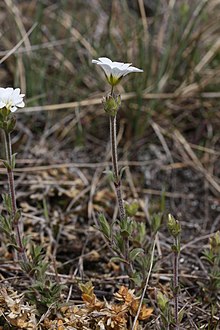| Cerastium arvense | |
|---|---|

| |
| Scientific classification | |
| Kingdom: | Plantae |
| Clade: | Tracheophytes |
| Clade: | Angiosperms |
| Clade: | Eudicots |
| Order: | Caryophyllales |
| Family: | Caryophyllaceae |
| Genus: | Cerastium |
| Species: | C. arvense |
| Binomial name | |
| Cerastium arvense L. | |
Cerastium arvense is a species of flowering plant in the pink family known by the common names field mouse-ear and field chickweed. It is a widespread species, occurring throughout Europe and North America, as well as parts of South America. It is a variable species. There are several subspecies, but the number and defining characteristics are disputed.

Description

Cerastium arvense is a perennial herb growing up to 30–45 cm (12–18 in) tall. It takes the form of a mat, clump, creeper, or upright flower, and may grow from a taproot or tangled system of rhizomes. It is usually somewhat hairy in texture, often with glandular hairs. The leaves are linear, lance-shaped, or oblong, and a few centimeters in length. The inflorescence may consist of a single flower to a dense cluster of many. The flower has five white petals, each with two lobes, and five hairy green sepals at the base. The fruit is a capsule up to 1.5 cm (0.59 in) long with ten tiny teeth at the tip, which contains several brown seeds.
Cultivation
Gardeners interested in wildflowers disagree on if field mouse-ears should be grown in gardens. Noted rock gardener Louise Beebe Wilder recommended against it in the strongest terms. However C.W. Wood and Claude A. Barr both thought that a specimen selected for good qualities had a place in a garden, such as a groundcover in difficult shady spots.
References
- "Cerastium arvense (Field Mouse-ear)". Online Atlas of the British and Irish flora. Retrieved 16 July 2014.
- "Cerastium arvense L." USDA. Retrieved 16 July 2014.
- ^ Flora of North America
- "Jepson Manual Treatment". Regents of the University of California. University of California, Berkeley. Retrieved 15 May 2017.
- Barr, Claude A. (1983). Jewels of the plains : wild flowers of the Great Plains grasslands and hills. Minneapolis: University of Minnesota Press. p. 55. ISBN 0-8166-1127-0.
External links
 Media related to Cerastium arvense at Wikimedia Commons
Media related to Cerastium arvense at Wikimedia Commons- Photo gallery
| Taxon identifiers | |
|---|---|
| Cerastium arvense |
|